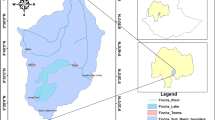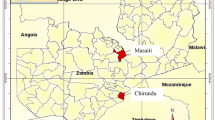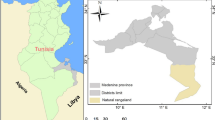Abstract
Smallholder farming is among the most vulnerable sectors due to its great social and economic sensitivity. Despite future climate change, current climate variability is already an issue of concern that justifies adaptation efforts. In Brazil, the Semi-Arid Region is a climate hotspot, well known for both historic socioeconomic setbacks, and agriculture failures caused by dry spells and severe droughts. In 2010, the Brazilian government enacted the National Policy on Climate Change, which states as one of its key goals the identification of vulnerabilities and the adoption of adequate measures of adaptation to climate change. The improvement of vulnerability assessment tools is a response to the growing demand of decision makers for regular information and indicators with high spatial and temporal resolution. This article aims at undertaking a comparative assessment of smallholder farming’s vulnerability to droughts. An integrated assessment system has been developed and applied to seven municipalities located in the Brazilian Semi-Arid Region (within the State of Ceará). Results show regional vulnerability contrasts driven by institutional and socioeconomic factors, beyond climatic stressors.

Similar content being viewed by others
References
Adger NW (2006) Vulnerability. Glob Environ Chang 16:268–281
Adger W, Dessai S, Goulden M et al (2009) Are there social limits to adaptation to climate change? Clim Chang 93:335–354
Alcamo J, Acosta-Michlik L, Carius A, Eierdanz F, Klein R, Krömker D, Tänzler D (2008) A new approach to quantifying and comparing vulnerability to drought. Reg Environ Chang 8(4):137–149
Bellon M, Hodson D, Hellin J (2011) Assessing the vulnerability of traditional maize seed systems in Mexico to climate change. Proc Natl Acad Sci U S A 108:13432–13437
Birkmann J (2007) Risk and vulnerability indicators at different scales: applicability, usefulness and policy implications. Environ Hazards 7(1):20–31
Bohle HG, Downing TE, Watts MJ (1994) Climate change and social vulnerability: toward a sociology and geography of food insecurity. Glob Environ Chang 4(1):37–48
Brasil (2005) Análise da vulnerabilidade da população brasileira aos impactos sanitários das mudanças climáticas. Ministério da Ciência e Tecnologia (MCT)
Brooks N, Adger WN, Kelly PM (2005) The determinants of vulnerability and adaptive capacity at the national level and the implications for adaptation. Glob Environ Chang 15(2):151–163
Byun HR, Wilhite D (1999) Objective quantification of drought severity and duration. J Clim 12:2747
CEDEPLAR, FIOCRUZ (2009) Mudanças climáticas, migrações e saúde: cenários para o Nordeste brasileiro: 2000–2050. Cedeplar; Fiocruz, Belo Horizonte
CPTEC (2010) Centro de Previsão de Tempo e Previsão Climática- Center for Weather Forecasts and Climate Studies. http://www.cptec.inpe.br. Accessed 18 Sept 2010
Cutter S (2008) Temporal and spatial changes in social vulnerability to natural hazards. Proc Natl Acad Sci 105:2301–2306
DIEESE (2008) Estatísticas do meio rural. Ministério do Desenvolvimento Agrário (MDA). http://www.dieese.org.br/anu/estatisticasMeioRural2008.pdfAccessed 14 Sept 2011
Dietz T, Ostrom E, Stern P (2003) The struggle to govern the commons. Science (New York, NY) 302:1907–1912
Diffenbaugh N, Giorgi F, Raymond L, Bi X (2007) Indicators of 21st century socioclimatic exposure. Proc Natl Acad Sci 104:20195–20198
Dovers S (2009) Normalizing adaptation. Glob Environ Chang 19:4–6
Dubreuil V (1997) La sécheresse dans la France de l’Ouest: une contrainte climatique trop souvent oubliée. Sécheresse 8:47–55
Dubreuil V (2005) Un risque climatique à géographie variable: la sécheresse dans la France de l’ouest. Risques Clim 1:147–173
Eakin H, Lemos MC (2010) Institutions and change: the challenge of building adaptive capacity in Latin America. Glob Environ Chang 20:1–3
Finan T, Nelson D (2001) Making rain, making roads, making do: public and private adaptations to drought in Ceará, Northeast Brazil. Clim Res 19:97–108
Ford JD, Smit B, Wandel J, MacDonald J (2006) Vulnerability to climate change in Igloolik, Nunavut: what we can learn from the past and present. Polar Record 42(221):127–138
Ford J, Smith T, Berrang-Ford L et al (2010) Case study and analogue methodologies in climate change vulnerability research. WIREs Clim Chang 1:374–392
Fraser EDG, Dougill AJ, Hubacek K et al (2011) Assessing vulnerability to climate change in dryland livelihood systems: conceptual challenges and interdisciplinary solutions. Ecol Soc 16:3
FUNCEME (2011) Fundação Cearense de Metereologia e Recursos Hídricos—Water Resources Foundation from Ceará. http://www.funceme.br/index.php/areas/meio-ambiente/indice-de-aridez. Accessed 12 Dec 2010
Gaiser T, Ferreira GR, Stahr K (2003) General view of the WAVES program. In: Global change and regional impacts: water availability and vulnerability of ecosystems and society in the semiarid northeast of Brazil. Springer, Berlin
Gallopín GC (2006) Linkages between vulnerability, resilience, and adaptive capacity. Glob Environ Chan Hum policy Dimens 16(3):293–303
Gregory S (1986) The climatology of drought. Geography 71:97–104
Hahn MB, Riederer AM, Foster SO (2009) The Livelihood Vulnerability Index: a pragmatic approach to assessing risks from climate variability and change—a case study in Mozambique. Glob Environ Chang 19(1):74–88
Holling CS, Meffe GK (1996) Command and control and the pathology of natural resource management. Conserv Biol 10:328–337
IBGE (2006) Instituto Brasileiro de Geografia e Estatísticas—Brazilian Institute of Geography and Statistics. Censo Agropecuário 2006. http://www.sidra.ibge.gov.br/bda/pesquisas/ca/default.asp?o=2andi=P. Accessed 14 Sept 2011
INMET (2010) Instituto Nacional de Meteorologia—National Institute of Meteorology. http://www.inmet.gov.br/. Accessed 18 Sept 2010
IPCC (2007) In: Core Writing Team, Pachauri RK, Reisinger A (eds) Climate change 2007: synthesis report. Contribution of Working Groups I, II and III to the Fourth Assessment Report of the Intergovernmental Panel on Climate Change. WMO, IPCC Secretariat, Geneva
Jones L, Boyd E (2011) Exploring social barriers to adaptation: insights from Western Nepal. Glob Environ Chang 21:1262–1274
Krol MS, Bronstert A (2007) Regional integrated modelling of climate change impacts on natural resources and resource usage in semi-arid Northeast Brazil. Environ Model Softw 22:259–268
Lemos M, Finan T, Fox R, Nelson D, Tucker J (2002) The use of seasonal climate forecasting in policymaking: lessons from Northeast Brazil. Clim Chang 55:479–507
Lobell DB, Banziger M, Magorokosho C et al (2011) Nonlinear heat effects on African maize as evidenced by historical yield trials. Nat Clim Chang 1:42–45
Lonergan S (1998) The role of environmental degradation in population displacement. Environ Chang Secur Proj Rep 4:5–15
Magalhães A, Glantz MH (1992) Socioeconomic impacts of climate variations and policy responses in Brazil. Esquel Brasil Foundation, Brasilia
Magalhães A, Rebouças O (1988) Introduction: drought as a policy and planning issue in Northeast Brazil. In: The impact of climatic variations on agriculture. Kluwer Academic Publishers, Dordrecht
Makurira H, Savenije H, Uhlenbrook S et al (2011) The effect of system innovations on water productivity in subsistence rainfed agricultural systems in semi-arid Tanzania. Agric Water Manag 98:1696–1703
Marengo J (2007) Caracterização do clima no Século XX e Cenários Climáticos no Brasil e na América do Sul para o Século XXI derivados dos Modelos Globais de Clima do IPCC. CPTEC/INPE
Marengo J, Jones R, Alves LM, Valverde MC (2009) Future change of temperature and precipitation extremes in South America as derived from the PRECIS regional climate modeling system. Int J Climatol J R Meteorol Soc 29:2241–2255
Marengo J et al (2010) Future change of climate in South America in the late twenty-first century: intercomparison of scenarios from three regional climate models. Clim Dyn 35:1073–1097
McKee TB, Doesken NJ, Kleist J (1993) The relationship of drought frequency and duration to time scales. In: Proceedings of the 8th Conference of Applied Climatology. Anaheim, CA. American Meterological Society, Boston, pp 179–184
Morton J (2007) The impact of climate change on smallholder and subsistence agriculture. Proc Natl Acad Sci U S A 104:19680–19685
Mueller V, Osgood D (2009) Long-term impacts of droughts on labour markets in developing countries: evidence from Brazil. J Dev Stud 45:1651–1662. doi:10.1080/00220380902935865
O’Brien K, Leichenko R, Kelkar U, Venema H, Aandahl G, Tompkins H, Javed A, Bhadwa S, Barg S, Nygaard L, West J (2004) Mapping vulnerability to multiple stressors: climate change and globalization in India. Glob Environ Chang 14(4):303–313
Palmer W (1965) Meteorological drought. U.S. Dept. of Commerce Weather Bureau; For sale by the Supt. of Docs. U.S. G.P.O., Washington
Parry M (2009) Overshoot, adapt and recover. Nature 458:1102–1103
Pinter L, Hardi P, Bartelmus P (2005) Sustainable development indicators: proposals for the way forward. International Institute for Sustainable Development, New York
Rooy MP (1965) A rainfall anomaly index independent of time and space. Notos 14:43–48
Rosenzweig C, Hillel D (2008) Climate variability and the global harvest impacts of El Nino and other oscillations on agro-ecosystems. Oxford University Press, USA
Rovere E, Avzaradel AC, Monteiro J (2009) Potential synergy between adaptation and mitigation strategies: production of vegetable oils and biodiesel in northeastern Brazil. Clim Res 40:233–239
Schipper E (2006) Conceptual history of adaptation in the UNFCCC process. Rev Eur Commun Int Environm Law 15:82–92
Smit B, Wandel J (2006) Adaptation, adaptive capacity and vulnerability. Glob Environ Chang Hum Policy Dimens 16:282
Smit B, Burton I, Klein RJ, Wandel J (2000) An anatomy of adaptation to climate change and variability. Clim Chang 45:223–251
Smithers J, Smit B (1997) Human adaptation to climatic variability and change. Glob Environ Chang 7:129–146
Sun L, Li H, Ward MN (2007) Climate variability and corn yields in semiarid Ceará, Brazil. J Appl Meteorol Climatol 46:226–240
Thornthwaite CW (1948) An approach toward a rational classification of climate. Geogr Rev 38:55–94. doi:10.2307/210739
Toni F, Holanda E (2008) The effects of land tenure on vulnerability to droughts in Northeastern Brazil. Glob Environ Chang 18:575–582
Torresan S, Critto A, Valle MD, Harvey N, Marcomini A (2008) Assessing coastal vulnerability to climate change: comparing segmentation at global and regional scales. Sustain Sci 3(1):45–65
Turner B, Kasperson R, Matson P et al (2003) A framework for vulnerability analysis in sustainability science. Proc Natl Acad Sci U S A 100:8074–8079
UNDP (2004) Reducing disaster risk: a challenge for development. United Nations Development Programme Bureau for Crisis Prevention and Recovery, New York
Villa M (2000) Vida e morte no sertão: história das secas no Nordeste nos séculos XIX e XX. Editora Atica, São Paulo
Vincent K (2007) Uncertainty in adaptive capacity and the importance of scale. Glob Environ Chang Hum Policy Dimens 17:12–24
Wilhite D (1996) Reducing the impacts of drought: progress toward risk management. In: Climate variability, climate change, and social vulnerability in the semi-arid tropics. Cambridge University Press, Cambridge
Acknowledgments
The authors wish to express their gratitude to Suely Salgueiro Chacon, Cristine Viana, and two anonymous reviewers and editors for the comments on an earlier version. Special thanks to Joana Araújo Maria for assistance and encouragement. The work reported here was undertaken within the Brazilian Research Network on Global Climate Change, supported by the Brazilian Ministry of Science and Technology.
Author information
Authors and Affiliations
Corresponding author
Additional information
This article is part of a Special Issue on “Climate change and adaptation in tropical basins” edited by Pierre Girard, Craig Hutton, and Jean-Phillipe Boulanger.
Electronic supplementary material
Below is the link to the electronic supplementary material.
ESM 1
(DOCX 91 kb)
Rights and permissions
About this article
Cite this article
Lindoso, D.P., Rocha, J.D., Debortoli, N. et al. Integrated assessment of smallholder farming’s vulnerability to drought in the Brazilian Semi-arid: a case study in Ceará. Climatic Change 127, 93–105 (2014). https://doi.org/10.1007/s10584-014-1116-1
Received:
Accepted:
Published:
Issue Date:
DOI: https://doi.org/10.1007/s10584-014-1116-1




